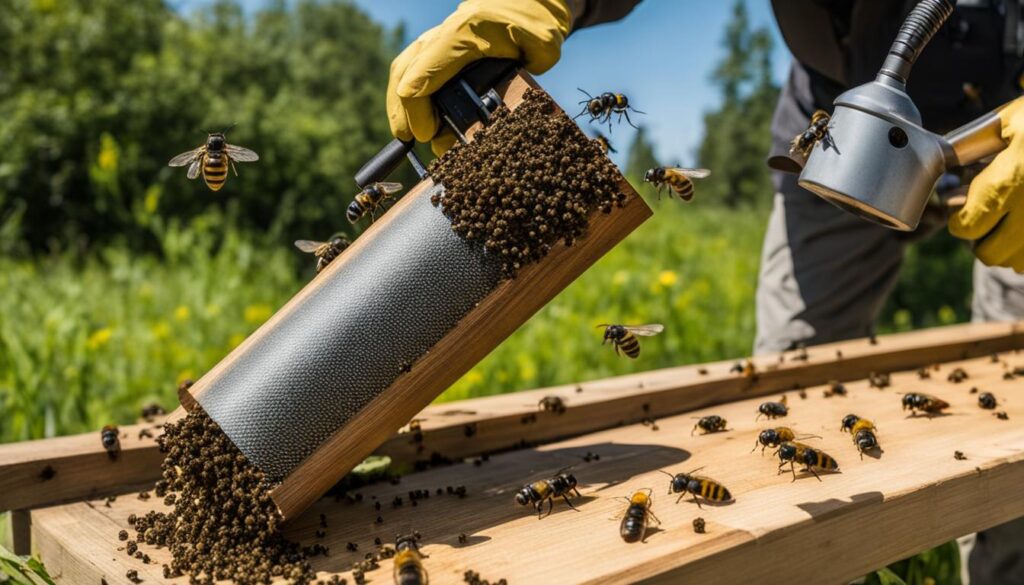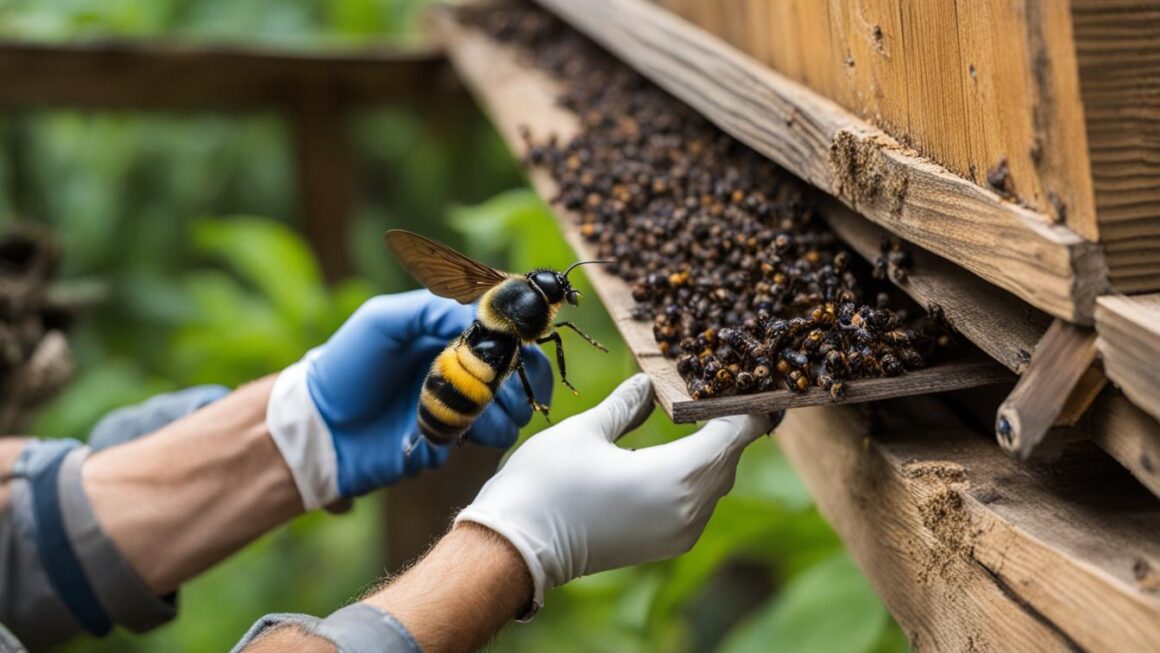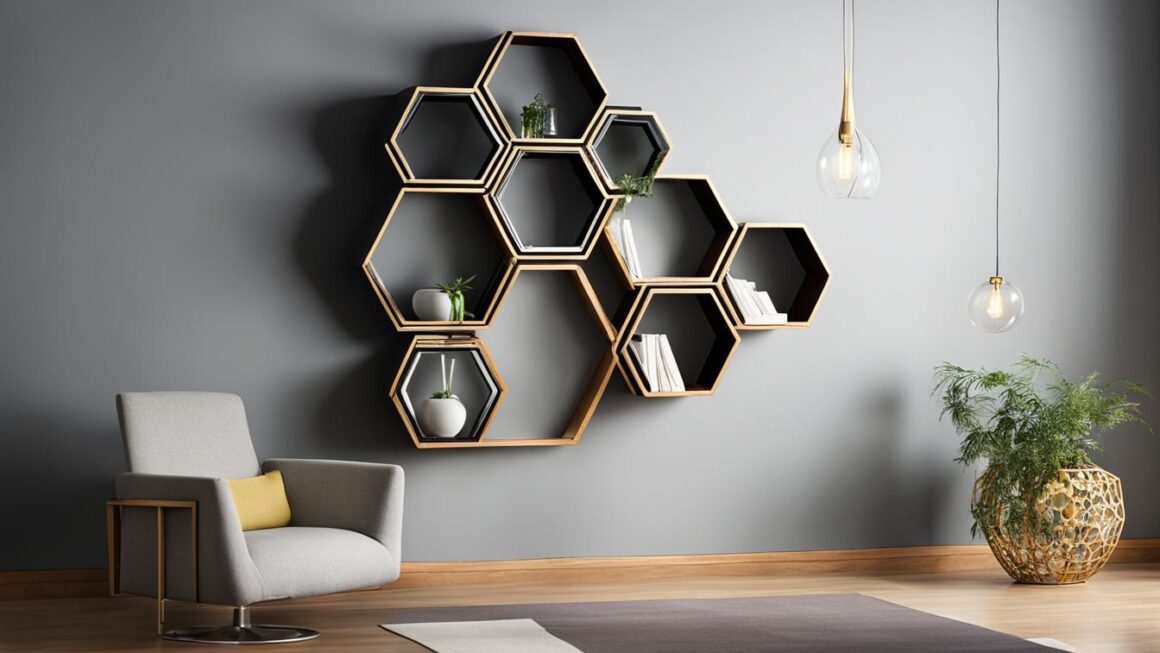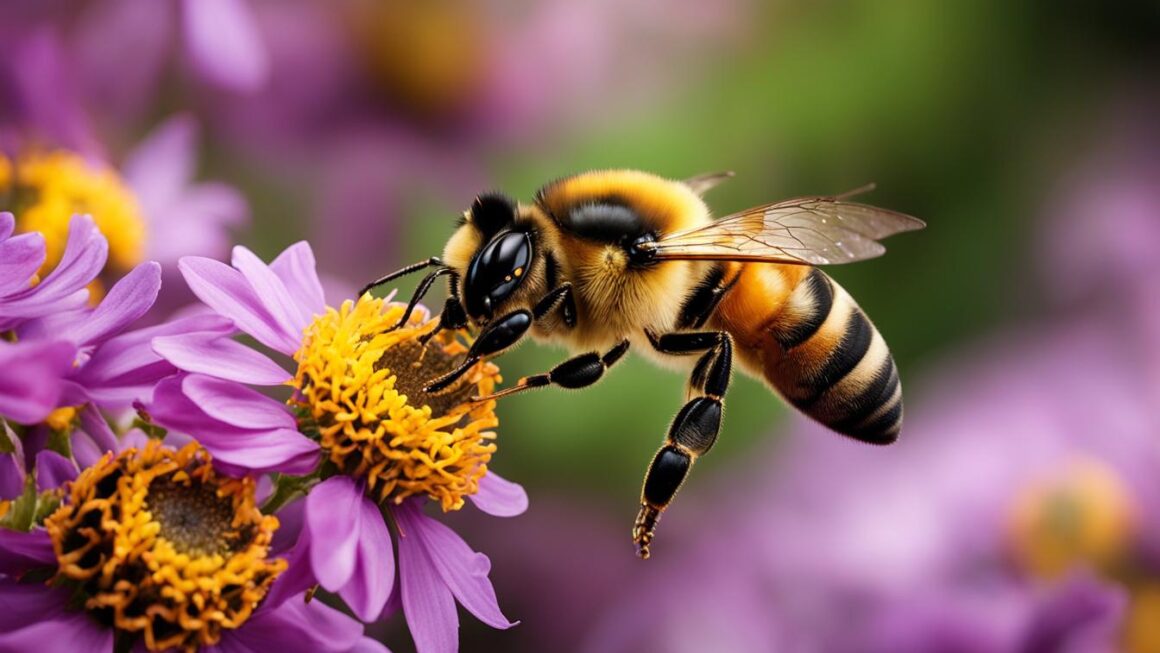Carpenter bees can be a persistent problem, causing damage to wooden structures and creating unsightly holes. However, with the right strategies, you can effectively control and prevent infestations. By understanding the behavior of carpenter bees and implementing preventive measures, you can safeguard your home from these wood-boring pests.
Key Takeaways:
- Implement preventive measures to deter carpenter bees from nesting in your home.
- Regularly inspect and maintain wood surfaces to identify and address any signs of infestation.
- Consider using natural remedies and physical barriers as a first line of defense against carpenter bees.
- If infestations are severe, consult with a professional pest control service for effective carpenter bee control.
- Long-term prevention includes ongoing maintenance and vigilance to minimize the risk of future infestations.
Identification of Carpenter Bees
Carpenter bees can often be mistaken for bumblebees due to their similar appearance. However, there are specific characteristics that can help you identify them:
- Large size: Carpenter bees are relatively bigger compared to other bees, with the females growing up to an inch long.
- Shiny black or metallic blue bodies: Unlike bumblebees, carpenter bees have smooth bodies that glisten in black or blue hues.
- Presence of fringes of hairs on their abdomens: This is a key feature that distinguishes carpenter bees from other similar-looking bees.
Knowing how to recognize carpenter bees is the first step in controlling their presence and preventing potential damage to your property. Take a close look at the bees you encounter and look for these distinctive characteristics.
Carpenter Bees Identification
| Characteristic | Details |
|---|---|
| Size | Up to 1 inch long |
| Body | Shiny black or metallic blue |
| Abdomen | Presence of fringes of hairs |
By being able to identify carpenter bees accurately, you can take appropriate measures to control their presence and prevent potential damage to wooden structures.
Quote: “Carpenter bees may look similar to bumblebees, but their distinct characteristics set them apart. Recognizing these differences is crucial for effective control.” – Carpenter Bee Control Expert
Life Cycle of Carpenter Bees
Carpenter bees have a fascinating life cycle that revolves around their nesting habits. Understanding this cycle is crucial in effectively controlling and preventing infestations. Let’s explore the stages of the carpenter bee life cycle and gain insights into their nesting habits.
The Life Stages of Carpenter Bees
- Egg Stage: The life cycle of a carpenter bee begins when the female bee lays her eggs inside prepared tunnels in wood. Each egg is placed in a separate cell and provided with a supply of pollen, which serves as nourishment for the developing larva.
- Larval Stage: After hatching from the egg, the larva feeds on the pollen provided by the mother. As it grows, it molts several times until it reaches full maturity. This stage can last anywhere from a few weeks to several months.
- Pupal Stage: Once the larva is fully developed, it spins a cocoon and enters the pupal stage. Inside the cocoon, the larva undergoes metamorphosis, transforming into an adult bee.
- Adult Stage: After completing the pupal stage, the fully developed adult carpenter bee emerges from the cocoon. The male bees generally emerge first, followed by the females. The adult bees feed on nectar and pollen, and the cycle continues as the females search for suitable nesting sites to lay their eggs.
Nesting Habits of Carpenter Bees
Carpenter bees are unique in their nesting habits. Unlike honeybees or bumblebees, they do not live in large colonies or hives. Instead, each female carpenter bee excavates her own individual tunnels in wood to create nesting sites. These tunnels can extend several feet into the wood, causing potential damage to structures.
Carpenter bees prefer to nest in softwoods, such as pine, cedar, or redwood, but they can also infest hardwoods under certain circumstances. They are drawn to unpainted or weathered wood, as it provides an ideal surface for excavating tunnels. Common nesting sites include eaves, fascia boards, wooden shingles, and outdoor wooden furniture.
It’s important to note that male carpenter bees do not have the ability to sting, but they can be aggressive and intimidating when protecting their territory. Female carpenter bees, on the other hand, can sting if provoked, although they rarely do so unless they feel threatened.
| Life Stage | Main Characteristics | Duration |
|---|---|---|
| Egg Stage | Eggs are laid in prepared tunnels inside wood | 1-2 weeks |
| Larval Stage | Larvae feed on pollen, molt several times | 5-7 weeks |
| Pupal Stage | Larva spins cocoon and undergoes metamorphosis | 2-3 weeks |
| Adult Stage | Fully developed bees emerge from cocoons | Lifespan: 2-3 weeks |
In summary, understanding the life cycle and nesting habits of carpenter bees is essential in implementing effective control strategies. By being aware of their preferred nesting materials and knowing the stages of their life cycle, homeowners can take proactive measures to prevent infestations and protect their properties from the potential damage caused by these wood-boring pests.
Damage Caused by Carpenter Bees
Carpenter bees pose a significant threat to wooden structures due to the damage they can cause. Their nesting habits involve excavating tunnels in wood, which weakens the integrity of timbers and can lead to structural issues. The impact of carpenter bees on wood structures includes unsightly holes and stains, as they enter and exit their nests. These holes can accumulate over time and further deteriorate the appearance and strength of the wood.
The extent of damage caused by carpenter bees depends on various factors, including the duration of infestation and the type of wood they target. Carpenter bees are particularly attracted to untreated, unpainted wood, such as cedar, redwood, and cypress. Softwoods like these are more easily tunneled into, making them vulnerable to extensive damage. Therefore, it is crucial to address carpenter bee infestations promptly and take preventive measures to protect wooden structures from further harm.
Signs of Carpenter Bee Damage
To determine whether your property has experienced damage caused by carpenter bees, there are a few common signs to look out for:
- Holes: Look for perfectly circular holes that are approximately 1/2 inch in diameter. These holes are typically found on wooden surfaces, such as siding, eaves, decks, and furniture.
- Wood Shavings: Carpenter bees discard wood shavings or sawdust near their nest entrances. This can create small piles of wood particles beneath the holes.
- Stains: As carpenter bees enter and exit their nests, they may leave behind staining caused by their excrement.
- Buzzing Sounds: You may hear buzzing sounds coming from the tunnels as carpenter bees are active within them.
If you notice any of these signs, it is advisable to address the issue promptly and implement carpenter bee control strategies to prevent further damage to your wooden structures.
| Wood Type | Vulnerability to Carpenter Bee Damage |
|---|---|
| Cedar | High |
| Redwood | High |
| Cypress | High |
| Pine | Moderate |
| Oak | Low |
It is important to note that even hardwoods like oak can still be susceptible to carpenter bee damage, although to a lesser extent. Taking preventive measures such as regular inspections, sealing cracks and crevices, and implementing carpenter bee control strategies can help mitigate the risk of damage to your wooden structures.
Natural, DIY, and Professional Carpenter Bees Control
Carpenter bees can be a persistent problem, but there are various approaches you can take to control their infestations. Depending on the severity of the issue and your preference for natural or professional methods, you can choose between natural carpenter bees control, DIY solutions, or seeking assistance from professional pest control services.
Natural Carpenter Bees Control: If you prefer to avoid using chemicals, there are several natural remedies that can help deter carpenter bees. Citrus fruit sprays made from lemon or orange peels can be effective in repelling these pests. The strong scent of citrus is a natural deterrent for carpenter bees. Almond oil is another natural option that can be applied to wooden surfaces to discourage bees from nesting. Additionally, playing loud music in areas where infestations are common can disrupt the bees’ activities and discourage nesting.
DIY Carpenter Bees Control: If you’re a hands-on homeowner, you can take proactive measures to control carpenter bee infestations. Start by inspecting your property for any signs of bee activity, such as holes in wood surfaces. Fill these holes with wood putty or caulk to prevent bees from reoccupying them. Painting or varnishing exposed wood surfaces can also act as a deterrent. Alternatively, you can implement physical barriers such as fine mesh or hardware cloth to cover vulnerable areas and prevent bees from accessing them.
Professional Carpenter Bees Control: If carpenter bee infestations are severe or widespread, it’s advisable to seek help from professional pest control services. Experienced professionals have the expertise and tools to effectively eliminate carpenter bee colonies and prevent further damage. They can assess the extent of the infestation, apply appropriate insecticides, and provide long-term prevention strategies. Professional carpenter bees control ensures thorough eradication and peace of mind knowing that your property is protected from these wood-boring pests.
Summary:
- Natural carpenter bees control: Citrus fruit sprays, almond oil, and loud music can help deter carpenter bees naturally.
- DIY carpenter bees control: Fill holes with wood putty or caulk, paint or varnish exposed wood surfaces, and use physical barriers like mesh or hardware cloth.
- Professional carpenter bees control: Seek assistance from pest control services for effective eradication and long-term prevention strategies.
Remember, preventing carpenter bee infestations is key. By implementing these control strategies, you can safeguard your property and maintain its structural integrity. Choose the method that suits your preferences and the severity of the infestation, and take proactive steps to keep carpenter bees at bay.
Natural Remedies for Carpenter Bees Control
When it comes to controlling carpenter bees, there are several natural remedies that can be effective in keeping these pests at bay. By utilizing these natural methods, you can address carpenter bee infestations without resorting to harmful chemicals. Here are some natural remedies that you can try:
- Citrus fruit sprays: Carpenter bees are repelled by the strong scent of citrus. Create a mixture of citrus fruit juice or peels and water, and spray it on the wooden surfaces that are prone to infestation. This will help deter the bees and discourage them from nesting.
- Almond oil: Carpenter bees are also deterred by the scent of almond oil. Apply almond oil to wooden surfaces using a cloth or brush. This will create a barrier that repels the bees and prevents them from drilling into the wood.
- Loud music: Believe it or not, carpenter bees are sensitive to vibrations. Playing loud music near the areas where they are active can disrupt their nesting patterns and encourage them to seek quieter locations away from your property.
Additionally, physical barriers can be used to prevent carpenter bees from accessing vulnerable wooden surfaces. Fine mesh or hardware cloth can be installed over openings, such as eaves or exposed beams, to keep the bees out. These barriers provide an effective deterrent while allowing for proper ventilation.

Remember that insecticides should be used as a supplementary method of control and not as the sole solution. Integrated pest management practices, such as preventive measures and natural remedies, should be implemented alongside the use of insecticides to achieve long-term carpenter bee control. By combining these strategies, you can effectively eliminate carpenter bees and protect your home from further infestations.
Tips for Long-Term Carpenter Bees Prevention
Carpenter bees can be a persistent problem, but there are several tips you can follow to prevent infestations and protect your property in the long run.
1. Regular Inspection and Maintenance: Conduct regular inspections of wood surfaces around your property, paying close attention to eaves, decks, fences, and other wooden structures. Look for signs of carpenter bee activity, such as small holes or sawdust-like debris. Fill any new holes promptly to prevent bees from establishing nests.
2. Protect Vulnerable Areas: Use wire screening or metal flashing to cover vulnerable areas, such as exposed wood or gaps in structures. This physical barrier can prevent carpenter bees from accessing these surfaces and deter them from nesting.
3. Paint or Varnish Exposed Wood: Carpenter bees are attracted to unpainted or unprotected wood. Regularly paint or varnish exposed wooden surfaces, as this can act as a deterrent to these pests. Be sure to cover all sides of the wood, including the undersides of decks and the backside of fences.
4. Remove Attractants: Carpenter bees are drawn to certain types of wood, especially softwoods like cedar, redwood, and cypress. If possible, avoid using these types of wood for construction in areas prone to carpenter bee activity.
5. Professional Pest Control: If you have a severe carpenter bee infestation or are unable to effectively control the problem on your own, consider hiring a professional pest control service. They have the knowledge and tools to safely and effectively eliminate carpenter bees and prevent future infestations.
By following these tips for long-term carpenter bee prevention, you can reduce the risk of structural damage to your property and enjoy a carpenter bee-free environment.
Conclusion
In conclusion, there are several effective strategies for controlling carpenter bees and preventing infestations in your home. By understanding the behavior and life cycle of carpenter bees, you can implement proactive measures to safeguard your property.
One of the key ways to control carpenter bees is through prevention. Using hardwoods for construction, regularly painting or varnishing exposed wood, and filling cracks and depressions in wooden surfaces can deter bees from nesting. Additionally, implementing long-term maintenance practices such as inspecting and maintaining wood surfaces can help minimize the risk of future infestations.
Furthermore, natural remedies can be used to repel carpenter bees without resorting to harmful chemicals. Citrus fruit sprays, almond oil, and loud music have shown effectiveness in deterring these pests. Physical barriers such as fine mesh or hardware cloth can also be utilized to prevent bees from accessing vulnerable wooden areas.
In cases of severe infestations or when structural integrity is at risk, insecticides can be used as a supplementary method of control. Dust formulations or desiccant dusts can be applied directly into nest holes to eliminate adult bees. However, it is important to follow safety precautions and consult with professionals to ensure the effective and safe use of insecticides.
FAQ
How can I identify carpenter bees?
Carpenter bees can be identified by their large size, shiny black or metallic blue bodies, and the presence of fringes of hairs on their abdomens.
What damage can carpenter bees cause?
Carpenter bees can weaken the integrity of wooden structures, create unsightly holes and stains, and cause potential structural damage.
How can I prevent carpenter bee infestations?
You can prevent carpenter bee infestations by using hardwoods for construction, filling cracks and depressions in wood surfaces, and regularly painting or varnishing exposed wood.
Are there natural remedies to control carpenter bees?
Yes, citrus fruit sprays, almond oil, and loud music can be effective deterrents. Using physical barriers such as fine mesh or hardware cloth can also prevent bees from accessing vulnerable wooden surfaces.
Can insecticides be used to control carpenter bees?
Insecticides can be used as a supplementary method of control. Dust formulations or desiccant dusts can be applied directly into nest holes to eliminate adult bees.
How can I prevent long-term carpenter bee infestations?
Regularly inspect and maintain wood surfaces, fill any new holes, and protect vulnerable areas with wire screening or metal flashing.




